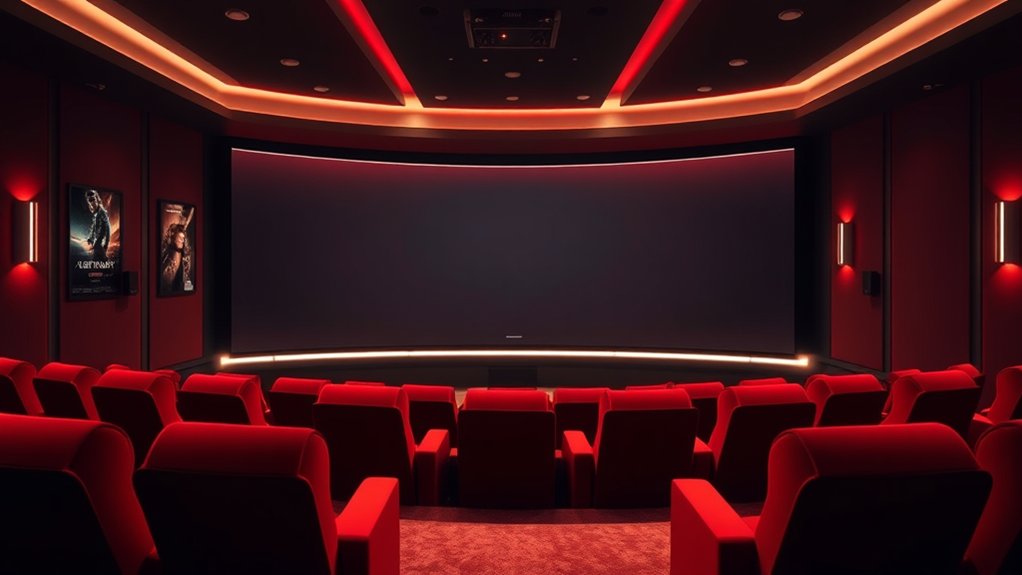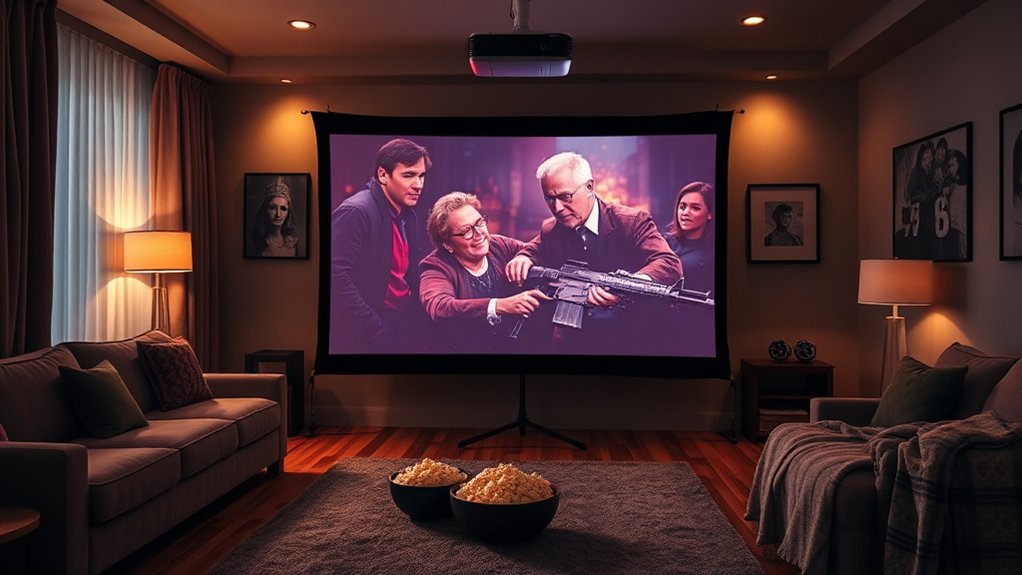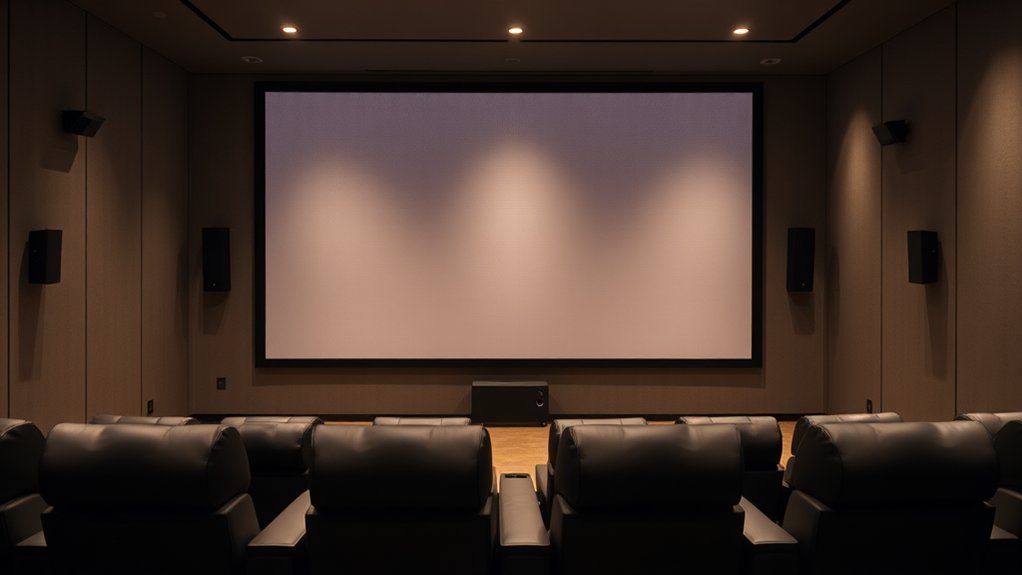To find the perfect screen size for your home theater, start by measuring your seating distance. A good rule of thumb is to multiply your distance in feet by 10, giving you the ideal screen size in inches—so if you’re 10 feet away, aim for an 80-inch screen. Remember, for 4K content, you can sit closer than with 1080p. Curious about how aspect ratios or resolution further influence your setup? There’s more to discover!
Key Highlights
- Measure your seating distance to determine ideal screen size; aim for an immersive 40-degree viewing angle.
- For 4K content, sit 0.8 times the screen width; for 1080p, sit 1.7 times the width.
- Use the “Rule of 10”: choose a screen size of 10 inches per foot of viewing distance.
- Align your screen’s aspect ratio with your common viewing habits for the best experience.
- Consider your budget, as costs for a home theater setup can vary widely based on equipment and room size.
Determining the Ideal Screen Size Based on Viewing Distance

When you’re setting up your home theater, figuring out the ideal screen size based on your viewing distance can feel a bit like solving a puzzle—but don’t worry, it’s easier than it sounds!
Start by measuring your seating distance from the screen. THX suggests a 40-degree viewing angle for maximum immersion, whereas SMPTE recommends 30 degrees for cinemas. If you’re watching 4K content, aim for about 0.8 times the screen width; with 1080p, it jumps to 1.7 times. For instance, if you sit 10 feet away, an 80-inch TV fits the bill perfectly. A larger screen size can enhance the overall experience, making it crucial to consider this factor when choosing the right TV size. Additionally, adhering to SMPTE guidelines for viewing angles can significantly improve image clarity and vibrancy.
Remember, sitting too close can strain your eyes and lessen that cinematic experience.
Understanding Aspect Ratios for Home Theater Screens
Choosing your home theater screen size is just one piece of the puzzle; the aspect ratio is another important factor that shapes how you experience your films and shows.
Aspect ratio defines the relationship between your screen’s width and height, and common formats like 16:9 and 2.4:1 each bring their benefits. For instance, a 16:9 screen works beautifully for most TV and gaming content, whereas a 2.4:1 ratio delivers a cinematic feel, ideal for movies. However, black bars can appear when watching 2.4:1 films on a 16:9 screen, potentially impacting your viewing experience. Nevertheless, using a 2.4:1 screen might lead to those annoying black bars when watching standard content—so, do you prefer immersive film experiences or versatility for streaming? Appropriate sizing is crucial for avoiding viewer fatigue during long viewing sessions, which can enhance overall enjoyment of your home theater setup.
In the end, aligning your screen’s aspect ratio with your viewing habits improves your home theater setup substantially.
The Impact of Resolution on Screen Size Selection
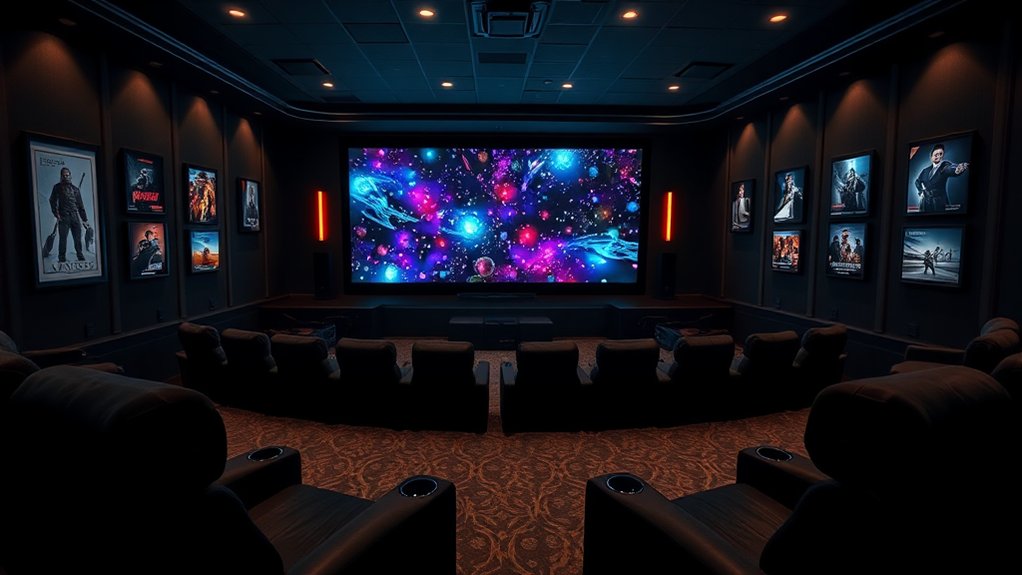
Understanding how resolution influences screen size selection can feel like maneuvering through a maze, especially with all the numbers tossed around.
Fundamentally, higher resolutions like 4K let you go larger without worrying about pixelation, allowing for an immersive experience. In particular, the suggested diagonal size for a 16×9 screen is based on a 30-degree viewing angle, ensuring that you achieve an optimal viewing experience without compromising image quality.
If you choose a 1080p screen, nevertheless, bigger mightn’t be better unless you sit further back. To keep things crisp, aim for a screen size that aligns with your projector’s capability—oversized screens with low resolution lead to visible pixel structures, which isn’t exactly the cinematic experience you want, right?
As a rule of thumb, higher resolution allows you to sit closer without losing image integrity.
Room Layout and Size Considerations for Optimal Viewing
How do you make the most of your home theater experience? Start by evaluating your room’s dimensions; the wall where the screen mounts will set limits on your screen size.
To optimize your home theater, first assess your room’s dimensions to determine the appropriate screen size.
Follow the “Rule of 10” for ideal viewing distance—every foot away should allow for 10 inches of screen diagonal (so, ten feet equals a 100-inch screen).
Your seating arrangement matters, too; avoid extreme angles or cramped spaces that can distort your view.
Position the screen at eye level to reduce neck strain and improve immersion.
Finally, consider your room’s lighting and colors; darker walls help reduce glare.
Budgeting for Your Home Theater Screen and Equipment
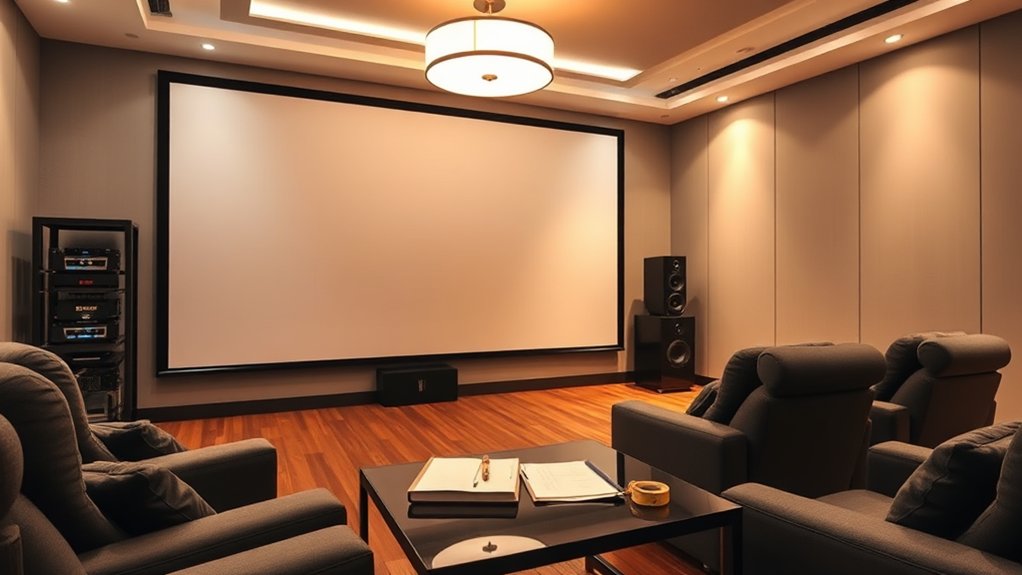
In regard to crafting your dream home theater, striking the right balance between quality and budget is essential for an enjoyable experience.
You could start with a basic setup around $2,000 to $5,000—a TV, a soundbar, and comfy seating. If you want improved audio and visuals, you’re likely looking at $10,000 to $20,000.
Larger spaces? Well, they can ramp up costs considerably because of extra seating and equipment—just imagine, a fancy surround sound system often demands a premium.
Opting for a smaller screen can keep budget-friendly, allowing funds for higher-quality audio.
In the end, it’s about prioritizing what matters to you, like clarity or sound. After all, would you rather have a massive screen that sounds like a tin can?
Frequently Asked Questions
How Can I Improve Viewing Angle in a Small Room?
To better your viewing angle in a small room, position your seating centrally, maintain ideal distance based on screen size, and use tiered seating if possible to improve sightlines and overall viewing comfort.
Are Screen Materials Important for Picture Quality?
Yes, screen materials are essential for picture quality. They affect color reproduction and sharpness. Choosing the right material improves your viewing experience, ensuring you enjoy vivid images and minimized distortion when watching your favorite films.
Can I Use a Projector With My Existing TV Screen?
You can’t use your existing TV screen with a projector. It isn’t designed to reflect projected light properly, leading to poor image quality. For the best experience, use a dedicated projection screen or blank wall instead.
How Do Lighting Conditions Affect My Screen Choice?
Lighting conditions greatly impact your screen choice. In bright rooms, opt for higher brightness screens or anti-glare surfaces. If you can control ambient light, go for screens designed for darker environments to improve image quality.
What Are the Best Practices for Screen Mounting Height?
To achieve ideal viewing, measure your eye level and position the screen’s bottom edge one-third its height below that point. This placement reduces neck strain and guarantees comfortable, direct viewing without excessive head movement.

